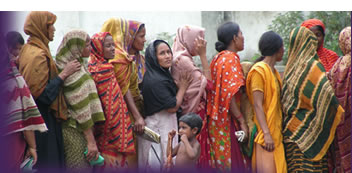|
|
|
Gender and Gender Mainstreaming |
|
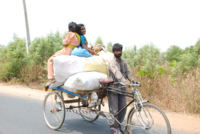 Gender refers not to women or men per se, but to the relations between them, both perceptual and material. Gender is not determined biologically, because of sexual characteristics of either women or men, but is constructed socially. It is a central organizing principle of societies, often governing the processes of production and reproduction, and consumption and distribution. Gender refers not to women or men per se, but to the relations between them, both perceptual and material. Gender is not determined biologically, because of sexual characteristics of either women or men, but is constructed socially. It is a central organizing principle of societies, often governing the processes of production and reproduction, and consumption and distribution.
Gender roles are the "social definition" of women and men, and vary among different societies and cultures, classes and ages, and during different periods in history. Gender-specific roles and responsibilities are often conditioned by the following:
- Household structure
- Accessible resources
- Specific impacts of the global economy
- Other locally relevant factors such as ecological conditions (FAO, 1997).
Almost everywhere, gender roles function in a way that discriminates against women, in their choices in life, their access to assets, and the voice they have in making decisions. This discrimination is not only reflected in individual relationships, but it also permeates social institutions.
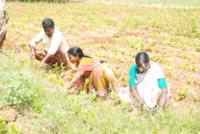 A gender approach distinguishes itself from an exclusive focus on women. The approach emphasizes the need for a case-by-case understanding of the following: A gender approach distinguishes itself from an exclusive focus on women. The approach emphasizes the need for a case-by-case understanding of the following:
- Specific dimension of social relations and power structures
- Relations between males and females
This method highlights the gender gaps between men and women in terms of employment, earnings, and access to control over and benefits from human and physical assets. It seeks to explain how these gaps affect power relations between women and men—and thus their relative ability to influence decisions within their households and communities.
Gender inequalities result in lesser food and income, and higher levels of poverty and food insecurity. The following four sets of factors and theirinteractions with policies and institutions (at the global, national and local levels) affect rural livelihoods (FAO, IFAD and World Bank, 2008).
- Assets
- Gender asymmetries in access to and control over assets (social, physical, financial, natural and human capitals)
- Markets
- Gender asymmetries in participation and power in land, labour, financial and product markets
- Gender differentiated distribution of risks and gains along value chains
- Information and Organisation
- Gender asymmetries in market information, extension services, skills and training
- Gender asymmetries in participation and leadership in rural organizations
- Gender asymmetries in rights, empowerment and political voice
- Risk and Vulnerability
- Gender asymmetries in household compositions and labour availability (dependency ratio, migration and disability)
- Physical and agro-ecological risks and their gender differentiated impacts
- Gender-responsive social protection measures
|
|
Sustainable Livelihoods through a Gender Lens |
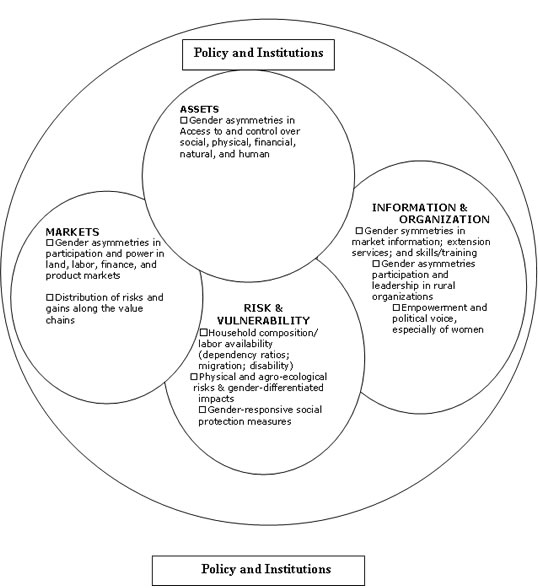 |
(Source: Gender in Agriculture Source Book by FAO, IFAD and World Bank) |
|
| |
|
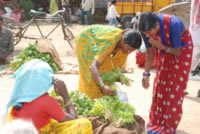 Gender mainstreaming is the recognition of gender-based divisions in labour, rights, resources and voice. It is not about adding a woman’s component or even a gender equality component into activities or projects. Mainstreaming a gender perspective “is the process of assessing the implications for women and men of any planned action, including legislation, policies or programmes, in any area and at all levels. It is a strategy for making the concerns and experiences of women as well as of men an integral part of the design, implementation, monitoring and evaluation of policies and programmes in all political, economic and societal spheres, so that women and men benefit equally, and inequality is not perpetuated. The ultimate goal of mainstreaming is to achieve gender equality" (ECOSOC, 1997). Gender mainstreaming is the recognition of gender-based divisions in labour, rights, resources and voice. It is not about adding a woman’s component or even a gender equality component into activities or projects. Mainstreaming a gender perspective “is the process of assessing the implications for women and men of any planned action, including legislation, policies or programmes, in any area and at all levels. It is a strategy for making the concerns and experiences of women as well as of men an integral part of the design, implementation, monitoring and evaluation of policies and programmes in all political, economic and societal spheres, so that women and men benefit equally, and inequality is not perpetuated. The ultimate goal of mainstreaming is to achieve gender equality" (ECOSOC, 1997).
Gender mainstreaming is an intrinsically time consuming activity. It involves changes in norms and values, cultural styles and normal ways of doing things, traditions and beliefs, people’s sense of self and their understanding of others.
Objectives of gender mainstreaming are as follows:
-
Overcome gender subordination, i.e., reduce and eliminate gender-based inequalities
-
Consider gender mainstreaming in all programme activities to attain gender equity
-
Develop a gender-sensitive monitoring parameters
Attention to women’s concerns and priorities in development policy and activity has evolved since the early 1970s. The issues were first discussed with a focus on projects designed only for women (women specific). Gradually, efforts were made to integrate women’s concerns into the projects without reference to gender equality (women’s component and integration). The current perspective is that the attention to women’s concerns is mainstreamed, and it requires a thoroughgoing re-evaluation of development priorities (UNDP, 2001).
Women Specific: Projects exclusively designed for women. Historically, such approaches were critiqued, as there was a tendency for women’s needs to be analysed as discrete from those of the rest of society. However, a full analysis of gender relations can indicate the need for women-specific interventions to compensate for past inequalities. A fully mainstreamed approach sometimes requires women-specific activities.
Women’s Component: Projects/activities provide separate resources and activities for women: generally formulated as an “add-on” after regular project planning. Such an approach is usually based on the assumption that women’s needs are broadly the same as men’s, and can be met through the same intervention. Women still perceived analytically as a discrete social category.
Integrated: Include women on an equal footing with men in all project activities. This is a further and more thorough implementation of the “add-on” approach. Women’s and men’s situation are typically analysed in a relational manner. However, interventions are based on the fallacy that issues of gender equality can be incorporated into a “business as usual” approach to development, which unless rigorously interrogated reflects the gender biases of society.
Mainstreamed: Awareness of, and commitment to women’s concerns and priorities infuse all the processes that determine development agendas. There is a conscious attempt to eliminate gender bias from project activities. All decision-making reflects the outcomes of socio-economic and policy analysis that is fully “gendered”. Analysis focuses on social relations, and particularly on the power relationships through which gender biases are protected and maintained.
Gender analysis: What to do?
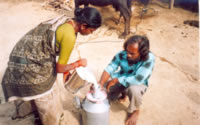 Gain an understanding of gender relations, the division of labour between men and women (who does what work), and who has access to, and control over, resources. Gain an understanding of gender relations, the division of labour between men and women (who does what work), and who has access to, and control over, resources. - Include domestic (reproductive) and community work in the work profile.
- Recognize the ways women and men work and contribute to the economy, their family and society.
- Use participatory processes and include a wide range of female and male stakeholders at the governmental level and from civil society, including women's organizations and gender equality experts.
- Identify barriers to women's participation and productivity (social, economic, legal, political, cultural...).
- Gain an understanding of women's practical needs and strategic interests, and identify opportunities to support both.
- Consider the differential impact of the initiative on men and women, and identify consequences to be addressed.
- Establish baseline data, ensure sex-disaggregated data, set measurable targets and identify expected results and indicators.
- Outline the expected risks (including backlash) and develop strategies to minimize these risks.
(Source: http://www.acdi-cida.gc.ca/acdi-cida/ACDI-CIDA.nsf/eng/ANN-612105312-KGB)
References:
ECOSOC (Economic and Social Council). 1997. Agreed Conclusions 1997/2, 18 July 1997. (Available at: http://www.unhcr.org/refworld/docid/4652c9fc2.html).
FAO.1997. What is Gender, FAO Corporate Document Repository (Available at http://www.fao.org/docrep/007/y5608e/y5608e01.htm).
FAO, IFAD and World Bank. 2008. Gender in Agriculture Source Book by FAO, IFAD and World Bank. ).
Available at http://siteresources.worldbank.org/INTGENAGRLIVSOUBOOK/Resources/CompleteBook.pdf
UNDP. 2001. Learning and Information Pack-Gender Analysis – United Nations Development Programme-Gender in Development Programme, January 2001.
(Available at: www.undp.org/women/docs/GM_INFOPACK/GenderAnalysis1.doc). |
|
| |
|
| |
|
|
|
